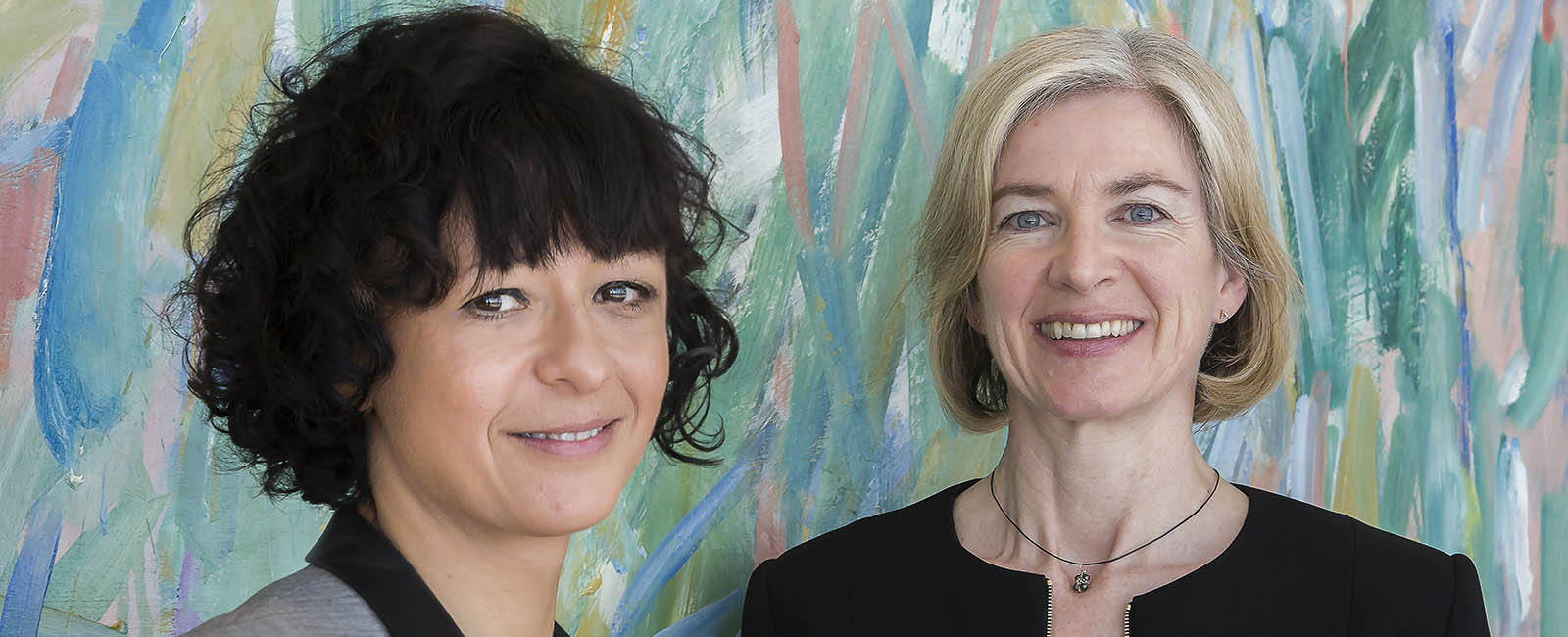
The Nobel Prize in Chemistry goes to Emmanuelle Charpentier and Jennifer Doudna, Frontiers of Knowledge Laureates in Biomedicine
Emmanuelle Charpentier and Jennifer Doudna, joint winners with Francisco Martínez Mojica of the 2017 BBVA Foundation Frontiers of Knowledge Award in Biomedicine, share this year’s Nobel Prize in Chemistry for “the development of a method for genomic editing.”
7 October, 2020
The Swedish institution describes the CRISPR/Cas9 technique, the “genetic scissors” capable of editing the DNA of animals, plants and microorganisms with extremely high precision, as having had “a revolutionary impact on the life sciences.” It is contributing, says the citation, “to new cancer therapies and may make the dream of curing inherited diseases come true.”
Three years ago the Frontiers of Knowledge committee in Biomedicine chose to add a third name, that of Spanish microbiologist Martínez Mojica, Principal Investigator of the Molecular Microbiology Group at the University of Alicante, on the grounds that his was the basic science discovery from which CRISPR was developed. Indeed it was Martínez Mojica who came up with the CRISPR name.
As the Frontiers of Knowledge citation states, “Martínez Mojica identified CRISPR sequences in bacteria and postulated their role as an adaptive defense system against viruses; Charpentier, Director of the Max Planck Unit for the Science of Pathogens in Berlin, and Doudna, a professor in the departments of Chemistry and Molecular and Cell Biology at the University of California, Berkeley, elucidated the molecular mechanism of CRISPR/Cas9 action and demonstrated its potential use as a universal tool for genome editing, paving the way for a multitude of applications in essentially any organism.”
After receiving the Frontiers of Knowledge Award, Jennifer Doudna recognized that it was Mojica’s “very inspirational” discovery in microorganisms which led her to begin her research in this field: “I began to work in CRISPR about 10 years ago, after reading a paper by Francisco Mojica which described repeated sequences of DNA in bacteria”.
Since it came into play as a genome editing tool in 2012, CRISPR/Cas9 has been used to search for new treatments against numerous diseases – including cancer and AIDS – as well as to breed new plant varieties and in environmental applications. The technique has cut the time required to voluntarily alter the genome from years to a matter of weeks, and many have hailed it as the democratization of gene editing, because it puts the technique within reach of any molecular biology lab.
A technique for ‘cutting and pasting’ DNA
The CRISPR revolution was born in Spain. In 1989, while working on a project to measure water quality along the region’s beaches, Mojica began his PhD thesis on a microorganism isolated in the salt marshes of Santa Pola, Haloferax mediterranei. He observed something strange in its genome: a series of genetic sequences repeating at regular intervals. There was nothing in the scientific literature to explain this oddity, and Mojica, intrigued, had to wait to have his own laboratory before trying to find out. Unable to obtain specific funding – “understandably,” he concedes, given the “elementary nature of a project that could go anywhere at all” – the young microbiologist began sifting through genomic databases, and discovered that regularly spaced repeat sequences occurred abundantly throughout the microbial world. This hinted at “major biological relevance.” And Mojica’s curiosity became obsession.
The “happiest moment by far” in Mojica’s scientific life came in 2003, when he finally uncovered the true nature of CRISPR: a defense mechanism microorganisms use to fend off viruses, something whose existence was entirely unsuspected. Mojica realized that the spaces between the repeat sequences carried fragments of the aggressor species’ genome; molecular signatures that could be recognized if they attacked again. In other words, a genetic vaccine.
Numerous groups immediately began competing to elucidate CRISPR’s exact mode of functioning. Charpentier, now at the Max Planck Institute for Infection Biology (Berlin, Germany) and the University of Umeå (Sweden), identified a key molecule in the CRISPR/ Cas9 system. Her attempts to solve its three-dimensional structure brought her into contact with Doudna, a reputed expert at the University of California, Berkeley (United States), and the two decided to join forces. In 2012 they managed to artificially reproduce the system, showing, as Charpentier explains, that it is “a powerful genome-editing tool that can be programmed to recognize any fragment of DNA.”
In nature, CRISPR/Cas9 destroys the attackers by slicing their DNA, with the Cas9 enzyme as the molecular scissors. In the lab, the viral DNA that CRISPR uses to recognize the enemy is replaced by another guide fragment, which steers the scissors to a specific genome region. The result is a technique that not only cuts DNA with exquisite precision, but also pastes it back in, along with new sequences if so desired.
After receiving the Frontiers of Knowledge Award, Charpentier declared that she was convinced of the immense biomedical potential of the CRISPR technique: “One promising avenue is its indirect use in biomedical experiments, where it can serve to pinpoint defective genes in animal models and thereby identify effective targets for new therapies. The technique will also help us correct harmful mutations in future gene therapy treatments.”
Doudna similarly shared her enthusiasm about the technique’s promise in biomedicine “both for its potential to advanced fundamental research about cells and how they function, but also as a tool for curing genetic disease.”

